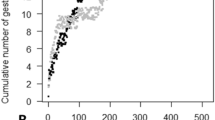Abstract
We studied the meaning of silent bared-teeth displays in a captive group of mandrills (Mandrillus sphinx). We observed the displays mostly in positive interactions, in which case they could advertise the sender's peaceful intentions, though at times they also occurred as a response to aggression. We found no relationship between the direction of agonistic interactions and the display. Both variants of the display, with closed or open jaws, exhibited mostly symmetrical patterns. The evolutionary convergence of the closed and open bared-teeth displays might be related to the dominance style of mandrills.
Similar content being viewed by others
References
Abernethy, K. A., White, L. J. T., and Wicking, E. J. (2002). Hordes of mandrills (Mandrillus sphinx): extreme group size and seasonal male presence. J. Zool. 258: 131–137.
Altmann, J. (1974). Observational study of behaviour: sampling methods. Behaviour 49: 227–265.
Andrew, R. J. (1963). The origin and evolution of the calls and facial expressions of the primates. Behaviour 20: 1–107.
Angst, W. (1974). Das Ausdrucksverhalten der Javeneraffen, Macaca fascicularis Raffles. Fortschritte der Verhaltensforschung, Vol. 15, Parey, Berlin.
Bernstein, I. S. (1970). Some behavioral elements of the Cercopithecoidea. In Napier, J. R., and Napier, P. H. (eds.), Old World Monkeys, Academic Press, New York, pp. 263–295.
Bolwig, N. (1964). Facial expressions in primates with remarks on a parallel development in certain carnivores (A preliminary report on work in progress). Behaviour 22: 167–192.
de Vries, H., Netto, W. J., and Hanegraaf, P. L. H. (1993). Matman: a program for the analysis of sociometric matrices and behavioural transition matrices. Behaviour 125: 157–175.
de Waal, F. B. M., and Luttrell, L. M. (1985). The formal hierarchy of rhesus macaques: an investigation of the bared-teeth display. Am. J. Primatol. 9: 73–85.
Dixson, A. F. (1998). Primate Sexuality, Oxford University Press, Oxford.
Douglas, J. M., and Sudd, J. H. (1980). Behavioural coordination between an aphis (Symydobius oblongus von Heyden; Hemiptera: Calliphidae) and the ant that attends it (Formica lugubris Zetterstedt; Hymenoptera: Formicidae): an ethological analysis. Anim. Behav. 28: 1127–1139.
Hoshino, J., Mori, A., Kudo, H., and Kawai, M. (1984). Preliminary report on the grouping of mandrills (Mandrillus sphinx) in Cameroon. Primates 25: 295–307.
Jouventin, P. (1975a). Observations sur la socio-écologie du mandrill. Terre et Vie 29: 493–532.
Jouventin, P. (1975b). Les róles des colorations du mandrill (Mandrillus sphinx). Z. Tierpsychol. 39: 455–462.
Mellen, J. D., Littlewood, A. P., Barrow, B. C., and Stevens, V. J. (1981). Individual and social behavior in a captive troop of mandrills (Mandrillus sphinx). Primates 22: 206–220.
Petit, O., Abegg, C., and Thierry, B. (1997). A comparative study of aggression and conciliation in three cercopithecine monkeys (Macaca fuscata, Macaca nigra, Papio papio). Behaviour 134: 415–432.
Petit, O., and Thierry, B. (1992). Affiliative function of the silent bared-teeth display in moor macaques (Macaca maurus): Further evidence for the particular status of Sulawesi macaques. Int. J. Primatol. 13, 97–105.
Preuschoft, S. (1992). “Laughter” and “smile” in Barbary macaques (Macaca sylvanus). Ethology 91: 220–236.
Preuschoft, S. (1995). ‘Laughter’ and ‘Smiling’ in Macaques. PhD. Thesis. Rijksuniversiteit Utrecht, Utrecht.
Preuschoft, S., and van Hooff, J. A. R. A. M. (1997). The social function of ‘smile’ and ‘laughter’: variations across primate species and societies. In Segerstråle, U., and Molnàr (eds.), Where Nature Meets Culture: Nonverbal Communication in Social Interaction, Erlbaum, Hillsdale, NJ, pp. 171–189.
Redican, W. (1975). Facial expressions in nonhuman primates. In Rosenblum, L. A. (ed.), Primate Behavior, Vol. 4, Academic Press, New York, pp. 103–194.
Rogers, M. E., Abernethy, K. A., Fontaine, B., Wickings, E. J., White, L. E. C., and Tutin, C. E. (1996). Ten days in the life of a mandrill horde in the Lopé Reserve, Gabon. Am. J. Primatol. 40: 297–313.
Setchell, J. M., and Dixson, A. F. (2002). Developmental variables and dominance rank in adolescent male mandrills (Mandrillus sphinx). Am. J. Primatol. 56: 9–25.
Siegel, S., and Castellan, N. J. (1988). Nonparametric Statistics for the Behavioral Sciences, McGraw-Hill, Singapore.
Thierry, B. (1986). A comparative study of aggression and response to aggression in three species of macaque. In Else, J. G., and Lee, P. C. (eds.), Primate Ontogeny, Cognition and Social Behaviour, Cambridge University Press, Cambridge, pp. 307–313.
Thierry, B. (2000). Covariation of conflict management patterns across macaque species. In Aureli, F., and de Waal, F. B. M. (eds.), Natural Conflict Resolution, University of California Press, Berkeley, pp. 106–128.
Thierry, B., Demaria, C., Preuschoft, S., and Desportes, C. (1989). Structural convergence between silent bared-teeth display and relaxed open-mouth display in the Tonkean macaque (Macaca tonkeana). Folia Primatol. 52: 178–184.
van Hooff, J. A. R. A. M. (1967). The facial displays of the catarrhine monkeys and apes. In Morris, D. (ed.), Primate Ethology, Weidenfeld& Nicolson, London, pp. 7–68.
van Hooff, J. A. R. A. M. (1972). A comparative approach to the phylogeny of laughter and smiling. In Hinde, R. A. (ed.), Non-verbal Commmunication, Cambridge University Press, Cambridge, UK, pp. 209–241.
Wickings, E. J., and Dixson, A. F. (1992). Testicular function, secondary sexual development, and social status in male mandrills (Mandrillus sphinx). Physiol. Behav. 52: 909–916.
Author information
Authors and Affiliations
Corresponding author
Rights and permissions
About this article
Cite this article
Bout, N., Thierry, B. Peaceful Meaning for the Silent Bared-Teeth Displays of Mandrills. Int J Primatol 26, 1215–1228 (2005). https://doi.org/10.1007/s10764-005-8850-1
Received:
Revised:
Accepted:
Issue Date:
DOI: https://doi.org/10.1007/s10764-005-8850-1




